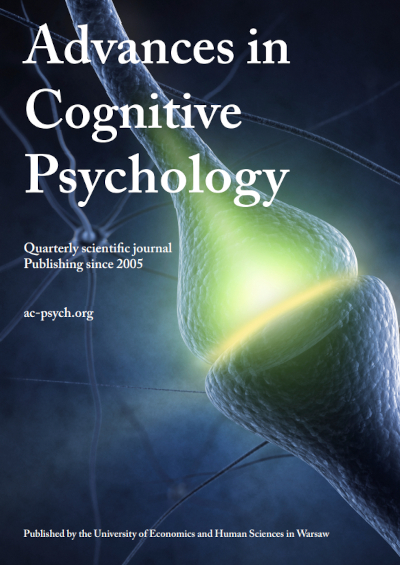Archive of all online content
-
Volume 21 Issue 4
pp. 309-324
(16 November 2025) -
Volume 21 Issue 3
pp. 212-308
(2 September 2025) -
Volume 21 Issue 2
pp. 120-211
(25 May 2025) -
Volume 21 Issue 1
pp. 1-93
(11 March 2025)
-
Volume 20 Issue 4
pp. 237-388
(20 November 2024) -
Volume 20 Issue 3
pp. 158-236
(19 August 2024) -
Volume 20 Issue 2
pp. 80-157
(24 June 2024) -
Volume 20 Issue 1
pp. 1-79
(1 March 2024)
-
Volume 19 Issue 4
pp. 1-105
(27 December 2023) -
Volume 19 Issue 3
pp. 211-333
(25 July 2023) -
Volume 19 Issue 2
pp. 111-200
(30 June 2023) -
Volume 19 Issue 1
pp. 1-110
(31 March 2023)
-
Volume 18 Issue 4
pp. 243-303
(31 December 2022) -
Volume 18 Issue 3
pp. 165-202
(30 September 2022) -
Volume 18 Issue 2
pp. 85-164
(30 June 2022) -
Volume 18 Issue 1
pp. 1-84
(31 March 2022)
-
Volume 17 Issue 4
pp. 250-291
(31 December 2021) -
Volume 17 Issue 3
pp. 193-249
(30 September 2021) -
Volume 17 Issue 2
pp. 99-192
(30 June 2021) -
Volume 17 Issue 1
pp. 1-98
(31 March 2021)
-
Volume 16 Issue 4
pp. 291-369
(31 December 2020) -
Volume 16 Issue 3
pp. 176-290
(30 September 2020) -
Volume 16 Issue 2
pp. 85-175
(30 June 2020) -
Volume 16 Issue 1
pp. 1-84
(31 March 2020)
-
Volume 15 Issue 4
pp. 236-317
(31 December 2019) -
Volume 15 Issue 3
pp. 169-235
(30 September 2019) -
Volume 15 Issue 2
pp. 75-168
(30 June 2019) -
Volume 15 Issue 1
pp. 1-74
(31 March 2019)
-
Volume 14 Issue 4
pp. 150-208
(31 December 2018) -
Volume 14 Issue 3
pp. 62-150
(30 September 2018) -
Volume 14 Issue 2
pp. 38-61
(30 June 2018) -
Volume 14 Issue 1
pp. 1-37
(31 March 2018)
-
Volume 13 Issue 4
pp. 267-322
(31 December 2017) -
Volume 13 Issue 3
pp. 190-266
(30 September 2017) -
Volume 13 Issue 2
pp. 121-189
(30 June 2017) -
Volume 13 Issue 1
pp. 1-120
(31 March 2017)
-
Volume 12 Issue 4 (special issue)
pp. 150-235
(31 December 2016) -
Volume 12 Issue 3
pp. 130-149
(30 September 2016) -
Volume 12 Issue 2
pp. 67-129
(30 June 2016) -
Volume 12 Issue 1
pp. 1-66
(31 March 2016)
-
Volume 11 Issue 4
pp. 118-135
(31 December 2015) -
Volume 11 Issue 3
pp. 64-117
(30 September 2015) -
Volume 11 Issue 2
pp. 31-63
(30 June 2015) -
Volume 11 Issue 1
pp. 1-30
(31 March 2015)
-
Volume 10 Issue 4
pp. 119-155
(31 December 2014) -
Volume 10 Issue 3
pp. 81-118
(30 September 2014) -
Volume 10 Issue 2
pp. 32-80
(30 June 2014) -
Volume 10 Issue 1
pp. 1-31
(27 February 2014)
-
Volume 9 Issue 4
pp. 156-223
(31 December 2013) -
Volume 9 Issue 3
pp. 112-155
(24 October 2013) -
Volume 9 Issue 2
pp. 53-111
(30 June 2013) -
Volume 9 Issue 1
pp. 1-52
(31 March 2013)
-
Volume 8 Issue 4
pp. 267-295
(31 December 2012) -
Volume 8 Issue 3
pp. 210-266
(27 September 2012) -
Volume 8 Issue 2
pp. 70-209
(28 June 2012) -
Volume 8 Issue 1
pp. 1-69
(29 March 2012)
-
Volume 7 Issue 2
pp. 55-156
(31 December 2011) -
Volume 7 Issue 1
pp. 1-54
(31 March 2011)
-
Volume 6 Issue 6
pp. 1-141
(31 December 2010)
-
Volume 5 Issue 5
pp. 1-134
(31 December 2009)
-
Volume 4 Issue 1
pp. 1-14
(31 March 2008)
-
Volume 3 Issue 4
pp. 419-465
(31 December 2007) -
Volume 3 Issue 3
pp. 363-417
(30 September 2007) -
Volume 3 Issue 1
pp. 1-361
(31 March 2007)
-
Volume 2 Issue 4
pp. 239-276
(31 December 2006) -
Volume 2 Issue 2
pp. 99-237
(30 June 2006) -
Volume 2 Issue 1
pp. 1-97
(31 March 2006)
-
Volume 1 Issue 1
pp. 1-16
()
Volume 21 Issue 4 (2025)
Faces of Forgiveness: The Impact of Emotional Facial Expressions on the Willingness to Forgive
Sebastian Binyamin Skalski-Bednarz, Loren L. Toussaint, Patrycja Uram, Robert Balas

Sebastian B. Skalski-Bednarz, Katholische Universität Eichstätt-Ingolstadt, Faculty of Philosophy and Education, Luitpoldstraße 32, 85071 Eichstätt, Germany.
Email: sebastian.skalski@ku.de
This study explored how facial emotional expressions influence the willingness to forgive, focusing on the role of sadness and attentional orientation under neutral and stress-induced conditions. An online survey was administered through Qualtrics to a U.S. sample (N = 246), employing scales to measure trait forgiveness, compassion, and willingness to forgive. Visual stimuli from the OASIS database were used to induce stress and present facial expressions, with a prior validation study (N = 215) selecting appropriate images displaying happy, neutral, and sad faces. The findings show that sad expressions significantly increased the willingness to forgive compared to neutral or happy expressions, supporting the empathy-altruism hypothesis. Trait forgiveness and compassion enhanced the willingness to forgive, highlighting the interplay between dispositional traits and situational factors. Attentional orientation towards emotional expressions varied with trait forgiveness under stress: those higher in trait forgiveness preferred happy faces. In contrast, those lower in trait forgiveness were more attentive to sad faces. These results suggest that recognizing emotional expressions has the potential to facilitate forgiveness, offering practical implications for conflict resolution strategies. Future research should address limitations such as cultural representation and the complexity of real-life emotional interactions using diverse samples and advanced techniques like eye-tracking.
Keywords: facial emotional expressions, attentional orientation, forgiveness, compassionExploring Grief: An In-Depth Analysis of Bereavement Counseling in The Initial Phases of Loss
Angela Maria Mackey, Krzysztof Kiełkiewicz

Krzysztof Kiełkiewicz, School of Human Sciences, VIZJA University, Okopowa 59, 01-043, Warsaw, Poland.
Email: kkielkiewicz@gmail.com
The objective of this study was to gain insight into the experiences of qualified therapists in counseling early-stage bereaved clients and to identify implications for clinical practice. Semi-structured qualitative interviews were conducted with psychotherapists experienced in bereavement counseling, using a phenomenological, thematic analysis approach. The primary objectives of early bereavement counseling are to normalize the client's experience, provide psychoeducation, assess emotional and functional risks, offer support through active listening, and create a safe space for emotional release. Empathy and attentive listening were found to be essential qualities for therapists. There were no risks associated with early bereavement counseling, which is in contrast to most current practice recommendations. The counseling session might be brief, and clients who need more help are urged to seek it out elsewhere. Comprehensive clinical work is not recommended at this early stage.
Keywords: early bereavement, counseling, psychotherapy, well-being, qualitative methodologyIs 'Better' Always Better? Cognitive Performance in Children with Misophonia vs. Controls
Marta Siepsiak, Anna Turek, Magdalena Michałowska, Małgorzata Gambin

Marta Siepsiak, Faculty of Psychology, SWPS University, Chodakowska 19/31, Warsaw, 03-815-, Poland.
Email: msiepsiak@swps.edu.pl
Misophonia is a disorder characterized by adverse reactions to specific repetitive sounds, such as oral and nasal noises made by humans (e.g., chewing, sniffing) and environmental sounds (e.g., animal licking, tapping). These reactions can manifest early in life and involve the nervous, autonomic, and perceptual systems. Cognitive functions appear to play a key role in how these stimuli are processed in individuals with misophonia. Although it is associated with various psychiatric disorders, it also presents distinct clinical features that suggest alterations in cognitive processing, particularly selective attention and inhibitory control. However, research on cognitive processes in situations without exposure to trigger sounds in individuals with misophonia, especially children, remains limited. Given that misophonia typically begins in childhood or adolescence, understanding its early cognitive profile is crucial. This study investigated cold cognitive processes, including inhibitory control, selective and divided attention, and verbal and abstract reasoning using performance-based tests in children with misophonia (n = 32) and controls without sound-related issues (n = 30), aged 7–17. Children with misophonia outperformed controls in divided attention (p < .001) and inhibitory control (p < .001), with no differences in other cognitive domains. Logistic regression showed that better inhibitory control increased the likelihood of misophonia, while linear regression indicated that misophonia status and selective attention predicted better inhibitory control. These results suggest that misophonia in children is related to enhanced inhibitory control rather than deficits in cognitive functioning. A better understanding of these cognitive processes could be an important step toward understanding the nature of misophonia, especially in pediatric populations.
Keywords: misophonia, cognitive functions, inhibitory control, children, pediatricFrontal Midline Theta Oscillation: An Electrophysiological Biomarker for Stereotype Control
Yixue Zhao, Haoran Lou, Billy Sung, Xiaoqin Wang, Lei Jia

Lei Jia, School of Psychology, Zhejiang Normal University No. 688 Yingbin Road, Jinhua, Zhejiang Province, 321004, PR China.
Email: jialei@zjnu.edu.cn
The neural oscillation of frontal midline theta (FMθ) has been proposed as an electrophysiological biomarker of cognition control modulated by the frontal executive control system. Recent research has demonstrated that stereotype control elicited by implicit stereotype violation can induce FMθ synchronization. However, given the distinct representation and processing mechanisms underlying explicit and implicit stereotypes, no study yet has investigated whether explicit stereotype violation can elicit FMθ synchronization, or whether FMθ synchronization can function as an indicator of stereotype control. To address these gaps, the current study utilized electrophysiological methods to investigate the stereotype control process elicited by explicit gender stereotype violation within an explicit lexical decision task. For the event-related potentials results, it was found that the N400 (but not the P600) component, was sensitive to stereotype consistency and gender factors. Specifically, trials involving stereotype-inconsistent (SI) stimuli elicited larger N400 amplitudes compared to stereotype-consistent (SC) trials. Time-frequency analysis revealed that SI trials induced an FMθ synchronization effect relative to SC trials, spanning the time window from the N400 to the P600 components. These findings extend previous research by demonstrating that FMθ neural oscillations can serve as a stable neural indicator reflecting stereotype control, applicable not only to implicit measures but also to explicit measures. Based on the temporal-sequence of the N400 and FMθ synchronization effects, it is proposed that the N400 effect may reflect the initial semantic conflict/anomaly monitoring of stereotype violations, while the FMθ synchronization may reflect a subsequent stereotype control mechanism in response to stereotype violations.
Keywords: stereotype violation, N400, frontal midline theta (FMθ), event-related potential (ERP)


